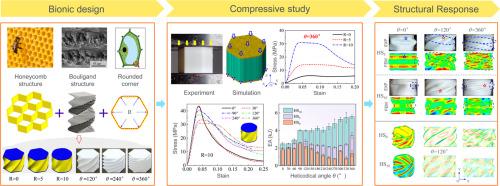Compressive behavior of 3D printed biomechanically inspired helicoidal honeycomb structures
IF 9.4
1区 工程技术
Q1 ENGINEERING, MECHANICAL
International Journal of Mechanical Sciences
Pub Date : 2025-09-23
DOI:10.1016/j.ijmecsci.2025.110883
引用次数: 0
Abstract
The impact resistance and energy absorption of lightweight structures remain a critical challenge for protective and aerospace applications. Conventional honeycomb designs are often limited by poor deformation stability and localized stress concentrations, which restrict their energy absorption efficiency. To overcome these limitations, this study proposes a novel biomechanically inspired helicoidal honeycomb sandwich structure (HS) that integrates Bouligand architecture with rounded-corner design, fabricated via 3D printing. The mechanical response of HS was systematically investigated by experiments and finite element simulations under varying helicoidal angles (0°–360°) and corner radii (0, 5, and 10 mm). Results reveal that larger helicoidal angles sacrifice strength and stiffness but promote deformation stability and smoother stress–strain plateaus, while rounded corners (R = 10 mm) effectively improve stress distribution and load-bearing capacity. The optimized configuration (θ = 360°, R = 10 mm) achieves a 184 % improvement in specific energy absorption compared to conventional counterparts. Mechanism analysis demonstrates a unique three-phase deformation process—flexible yielding, stable deformation, and multi-point energy absorption—attributed to the synergistic effect of helicoidal geometry and corner optimization. This work offers new design insights for lightweight, impact-resistant sandwich structures with potential applications in aerospace, protective engineering, and related fields.

3D打印生物力学启发的螺旋蜂窝结构的压缩行为
轻质结构的抗冲击性和能量吸收仍然是防护和航空航天应用的关键挑战。传统的蜂窝设计经常受到变形稳定性差和局部应力集中的限制,这限制了它们的能量吸收效率。为了克服这些限制,本研究提出了一种新的生物力学启发的螺旋蜂窝夹层结构(HS),该结构将Bouligand建筑与圆角设计相结合,通过3D打印制造。通过实验和有限元模拟,系统研究了HS在不同螺旋角(0°-360°)和转角半径(0,5和10 mm)下的力学响应。结果表明,较大的螺旋角会牺牲强度和刚度,但会促进变形稳定性和平滑应力-应变高原,而圆角(R = 10 mm)可有效改善应力分布和承载能力。优化后的结构(θ = 360°,R = 10 mm)与传统结构相比,比能吸收提高了184%。机理分析表明,螺旋形几何与转角优化协同作用,形成了柔性屈服、稳定变形、多点能量吸收的独特三相变形过程。这项工作为轻质、抗冲击夹层结构的设计提供了新的见解,在航空航天、防护工程和相关领域具有潜在的应用前景。
本文章由计算机程序翻译,如有差异,请以英文原文为准。
求助全文
约1分钟内获得全文
求助全文
来源期刊

International Journal of Mechanical Sciences
工程技术-工程:机械
CiteScore
12.80
自引率
17.80%
发文量
769
审稿时长
19 days
期刊介绍:
The International Journal of Mechanical Sciences (IJMS) serves as a global platform for the publication and dissemination of original research that contributes to a deeper scientific understanding of the fundamental disciplines within mechanical, civil, and material engineering.
The primary focus of IJMS is to showcase innovative and ground-breaking work that utilizes analytical and computational modeling techniques, such as Finite Element Method (FEM), Boundary Element Method (BEM), and mesh-free methods, among others. These modeling methods are applied to diverse fields including rigid-body mechanics (e.g., dynamics, vibration, stability), structural mechanics, metal forming, advanced materials (e.g., metals, composites, cellular, smart) behavior and applications, impact mechanics, strain localization, and other nonlinear effects (e.g., large deflections, plasticity, fracture).
Additionally, IJMS covers the realms of fluid mechanics (both external and internal flows), tribology, thermodynamics, and materials processing. These subjects collectively form the core of the journal's content.
In summary, IJMS provides a prestigious platform for researchers to present their original contributions, shedding light on analytical and computational modeling methods in various areas of mechanical engineering, as well as exploring the behavior and application of advanced materials, fluid mechanics, thermodynamics, and materials processing.
 求助内容:
求助内容: 应助结果提醒方式:
应助结果提醒方式:


